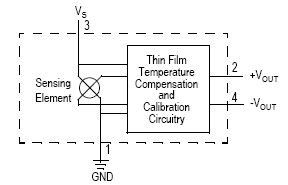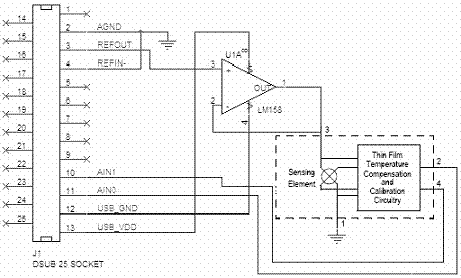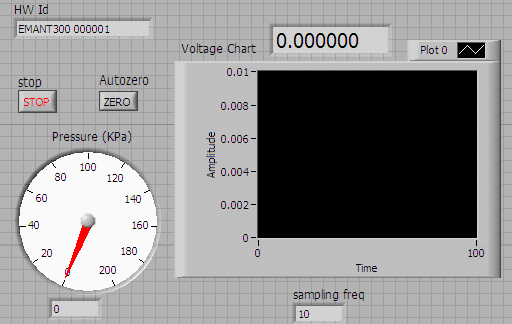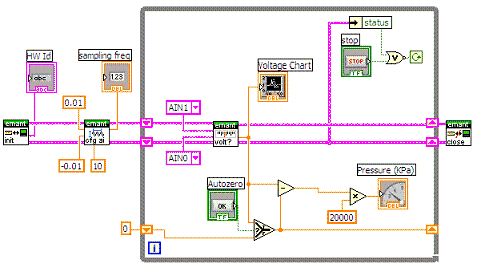Measure Pressure using silicon piezoresistive pressure sensor
Pressure is defined as a force per unit area and the U tube manometer is traditionally used to measure it. Manometers can measure absolute, gauge, and differential pressure. In a sense all pressure measurements are differential and the difference between the three types of measurement is the reference used.
In absolute pressure measurement, the reference is absolute vacuum. One application is the barometer which measures air pressure. High air pressure generally bring good weather and centers of storm are areas of relatively low air pressure.
To measure gauge pressure, the reference is the standard atmosperic pressure. The standard atmospheric pressure defined at sea-level at 0oC is 101.325 kPa (kilo Pascal absolute).
Some alternative units of pressure
-
1 bar - 100 kPa
-
1 mm Hg - 0.133 kPa
-
1 inch Hg - 3.386 kPa
-
1 psi - 0.145038 kPa
Blood pressure measurement is a gauge pressure measurement
Differential pressure measurement can be used to measure flow rate. When airflow is interrupted by a venturi or orifice, the measured pressure differential is related to the flow rate.
In this application note, we will make use of the low cost MPX2200 (US$17 from Digikey) series of Pressure Sensors from Freescale Semiconductors. An alternative supplier of Pressure Sensors is Honeywell Inc.
The MPX2200 series device is a silicon piezoresistive pressure sensor that provides a highly accurate and linear voltage output - directly proportional to the applied pressure. The sensor is a single monolithic silicon diaphragm with the strain gauge and a thin-film resistor network integrated on-chip. The chip is laser trimmed for precise span and offset calibration and temperature compensation.
They are designed for use in applications such as pump/motor controllers, robotics, level indicators, medical diagnostics, pressure switching, barometers, altimeters, etc.
Features
-
Temperature Compensated Over 0C to +85C
-
+/-0.25% Linearity (MPX2200D)
-
Available in Absolute, Differential and Gauge Configurations
 The differential voltage output of the sensor is directly proportional to the differential pressure applied. The absolute sensor has a built-in reference vacuum. The output voltage will decrease as vacuum, relative to ambient, is drawn on the pressure (P1) side. The output voltage of the differential or gauge sensor increases with increasing pressure applied to the pressure (P1) side relative to the vacuum (P2) side.
The differential voltage output of the sensor is directly proportional to the differential pressure applied. The absolute sensor has a built-in reference vacuum. The output voltage will decrease as vacuum, relative to ambient, is drawn on the pressure (P1) side. The output voltage of the differential or gauge sensor increases with increasing pressure applied to the pressure (P1) side relative to the vacuum (P2) side.
With a 10V excitation, it measures from 0 TO 200 kPA (0 TO 29 psi) giving a 40 mV full scale span. The output is ratiometric when excited by voltages lower than 10V.
In our example, we are using the absolute sensor and the sensor is excited at VEXC=2.5V. As the current required at the bridge is much higher than what is available from REFOUT, a simple buffer amplifier is required.

Since the excitation voltage is 2.5V, the full span output is scaled to 10mV. When the input of the EMANT300 is set to this range, the module can measure better than 1uV due to its programmable gain amplifier and the resolution of the ADC.
Thus the pressure in kPa with respect to the voltage output VO (seen at the differential input AIN1, AIN0) is given by
ρ = VO * 20000
The LabVIEW VI that reads the voltage across the bridge, converts the voltage to pressure kPa is called EMANT300 Example Pressure.VI As the sensor measures absolute pressure, the autozero function adjust for gauge measurement if zeroed against atmospheric pressure.
Front Panel

Block Diagram
